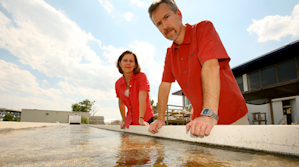
Researchers J. Emmett Duffy and Elizabeth Canuel look over the algae flowway on the VIMS Gloucester Point campus. Photo credit: VIMS.
President Obama may rue the day when he touted algae-based biofuels as a long-term solution for rising energy costs. Conservatives from Newt Gingrich to Charles Krauthammer have subjected the idea to endless mockery. Google “Obama algae for fuel” and you’ll hit a treasure trove of ridicule and satire. Lucky thing for Obama that the late night comedians are in his pocket, or we’d see endless japes about the devolution of green fuels into green slime.
There are legitimate reasons to be skeptical. According to a Gingrich newsletter, fuel from algae costs anywhere from $140 to $900 per barrel to produce today. On the other hand, it was only a few years ago that oil was selling for $140 per barrel. Furthermore, research into algae production and conversion into useful forms of energy is a recent phenomenon. Scientists are still wrapping their arms around the challenge. While I vociferously oppose government picking technology winners and losers for commercialization — witness Solyndra and the other solar-technology debacles — I do believe it is a legitimate role of government to sponsor basic R&D.
It happens that one of the more interesting experiments in algae R&D is taking place at the Virginia Institute of Marine Science. VIMS differs from other research initiatives by focusing on wild strains of algae that grow naturally in the Chesapeake Bay. One of Virginia’s biggest environmental problems is the algae blooms that sink, decompose, soak up oxygen and kill the fish. Figuring out a way to harvest the algae blooms early in their life cycle could save the lives of a lot of underwater critters.
While other algae growers have to fertilize their crop, Chesapeake Bay algae gets its fertilizer — phosphorous and nitrogen from farms and household yards upstream — for free. Researchers suggest harvesting algae at points along the Bay where phosphorous and nitrogen inputs are concentrated, according to a 2010 VIMS article. “We want it to be like a factory,” said William Cooke, a William and Mary physics professor.
“I see the nutrient-reduction and the fuel production as going hand in hand,” said J. Emmett Duffy, a VIMS marine science professor. “We like to think of it as turning pollution into fuel.
Will harvesting algae blooms become an economically viable activity? I have no idea. But I will say this. The Chesapeake Algae Project, of which VIMS is a part, was supported by a $3 million grant from Norwegian oil company Statoil. Meanwhile, Exxon Mobil has invested $600 million into algae-based biofuels in partnership with Craig Venter, the guy who first cracked the human genome. I have a lot more faith in the likes of Exxon, Statoil and Venter to pick the best technologies than I do in the federal government. If nothing else, capitalists aren’t swayed by campaign donations. But the idea of algae-based fuels may not be as hare-brained as Obama’s critics think.
— JAB


